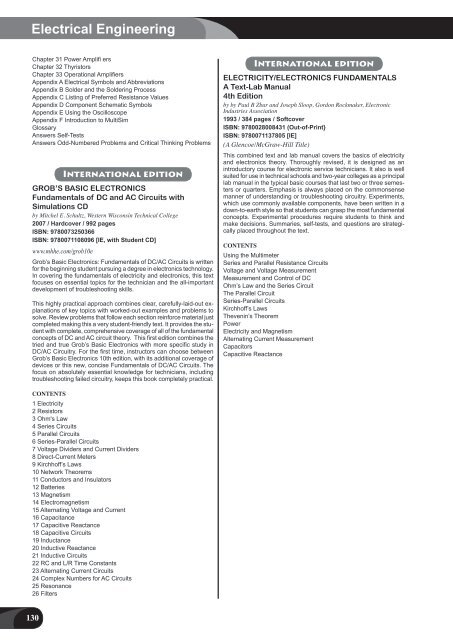Computer Science & Electrical Engineering 2012 - McGraw-Hill Books
Computer Science & Electrical Engineering 2012 - McGraw-Hill Books
Computer Science & Electrical Engineering 2012 - McGraw-Hill Books
You also want an ePaper? Increase the reach of your titles
YUMPU automatically turns print PDFs into web optimized ePapers that Google loves.
<strong>Electrical</strong> <strong>Engineering</strong><br />
Chapter 31 Power Amplifi ers<br />
Chapter 32 Thyristors<br />
Chapter 33 Operational Amplifiers<br />
Appendix A <strong>Electrical</strong> Symbols and Abbreviations<br />
Appendix B Solder and the Soldering Process<br />
Appendix C Listing of Preferred Resistance Values<br />
Appendix D Component Schematic Symbols<br />
Appendix E Using the Oscilloscope<br />
Appendix F Introduction to MultiSim<br />
Glossary<br />
Answers Self-Tests<br />
Answers Odd-Numbered Problems and Critical Thinking Problems<br />
International edition<br />
gROB’S BASIC ELECTRONICS<br />
Fundamentals of DC and AC Circuits with<br />
Simulations CD<br />
by Mitchel E. Schultz, Western Wisconsin Technical College<br />
2007 / Hardcover / 992 pages<br />
ISBn: 9780073250366<br />
ISBn: 9780071108096 [IE, with Student CD]<br />
www.mhhe.com/grob10e<br />
Grob’s Basic Electronics: Fundamentals of DC/AC Circuits is written<br />
for the beginning student pursuing a degree in electronics technology.<br />
In covering the fundamentals of electricity and electronics, this text<br />
focuses on essential topics for the technician and the all-important<br />
development of troubleshooting skills.<br />
This highly practical approach combines clear, carefully-laid-out explanations<br />
of key topics with worked-out examples and problems to<br />
solve. Review problems that follow each section reinforce material just<br />
completed making this a very student-friendly text. It provides the student<br />
with complete, comprehensive coverage of all of the fundamental<br />
concepts of DC and AC circuit theory. This first edition combines the<br />
tried and true Grob’s Basic Electronics with more specific study in<br />
DC/AC Circuitry. For the first time, instructors can choose between<br />
Grob’s Basic Electronics 10th edition, with its additional coverage of<br />
devices or this new, concise Fundamentals of DC/AC Circuits. The<br />
focus on absolutely essential knowledge for technicians, including<br />
troubleshooting failed circuitry, keeps this book completely practical.<br />
CoNteNts<br />
1 Electricity<br />
2 Resistors<br />
3 Ohm's Law<br />
4 Series Circuits<br />
5 Parallel Circuits<br />
6 Series-Parallel Circuits<br />
7 Voltage Dividers and Current Dividers<br />
8 Direct-Current Meters<br />
9 Kirchhoff’s Laws<br />
10 Network Theorems<br />
11 Conductors and Insulators<br />
12 Batteries<br />
13 Magnetism<br />
14 Electromagnetism<br />
15 Alternating Voltage and Current<br />
16 Capacitance<br />
17 Capacitive Reactance<br />
18 Capacitive Circuits<br />
19 Inductance<br />
20 Inductive Reactance<br />
21 Inductive Circuits<br />
22 RC and L/R Time Constants<br />
23 Alternating Current Circuits<br />
24 Complex Numbers for AC Circuits<br />
25 Resonance<br />
26 Filters<br />
130<br />
130<br />
International edition<br />
ELECTRICITY/ELECTRONICS FUNDAMENTALS<br />
A Text-Lab Manual<br />
4th Edition<br />
by by Paul B Zbar and Joseph Sloop, Gordon Rockmaker, Electronic<br />
Industries Association<br />
1993 / 384 pages / Softcover<br />
ISBn: 9780028008431 (Out-of-Print}<br />
ISBn: 9780071137805 [IE]<br />
(A Glencoe/<strong>McGraw</strong>-<strong>Hill</strong> Title)<br />
This combined text and lab manual covers the basics of electricity<br />
and electronics theory. Thoroughly revised, it is designed as an<br />
introductory course for electronic service technicians. It also is well<br />
suited for use in technical schools and two-year colleges as a principal<br />
lab manual in the typical basic courses that last two or three semesters<br />
or quarters. Emphasis is always placed on the commonsense<br />
manner of understanding or troubleshooting circuitry. Experiments,<br />
which use commonly available components, have been written in a<br />
down-to-earth style so that students can grasp the most fundamental<br />
concepts. Experimental procedures require students to think and<br />
make decisions. Summaries, self-tests, and questions are strategically<br />
placed throughout the text.<br />
CoNteNts<br />
Using the Multimeter<br />
Series and Parallel Resistance Circuits<br />
Voltage and Voltage Measurement<br />
Measurement and Control of DC<br />
Ohm’s Law and the Series Circuit<br />
The Parallel Circuit<br />
Series-Parallel Circuits<br />
Kirchhoff’s Laws<br />
Thevenin’s Theorem<br />
Power<br />
Electricity and Magnetism<br />
Alternating Current Measurement<br />
Capacitors<br />
Capacitive Reactance

















